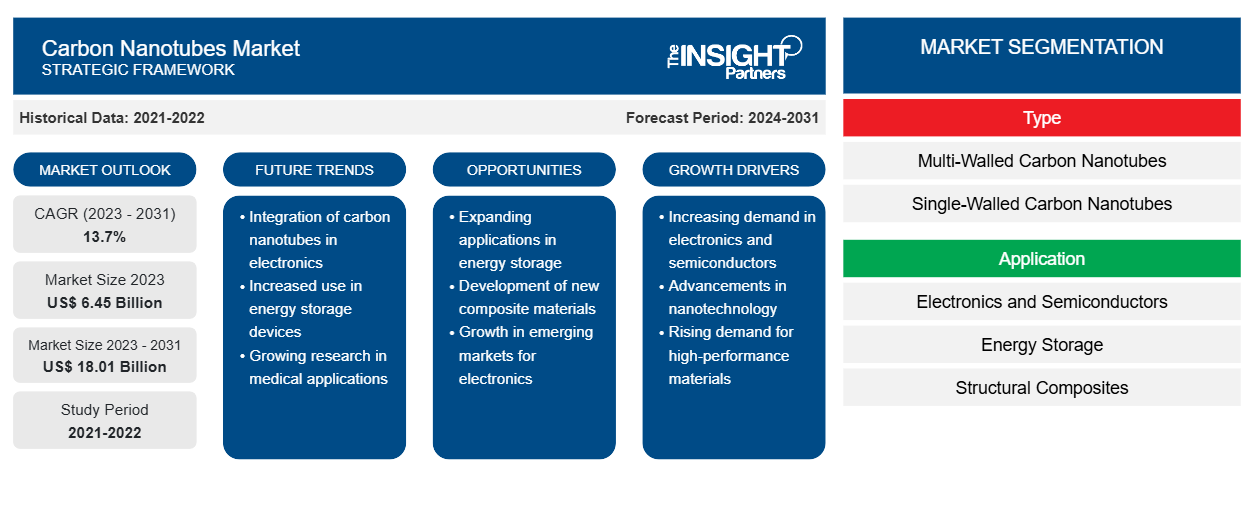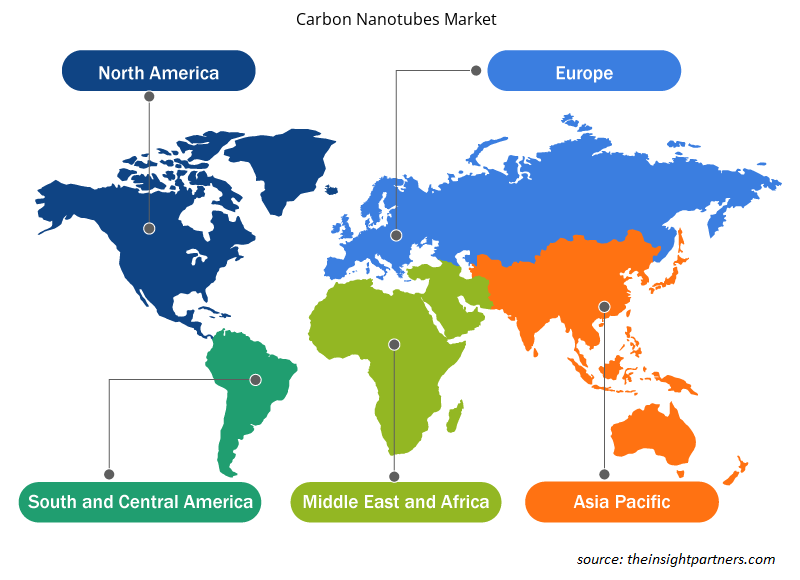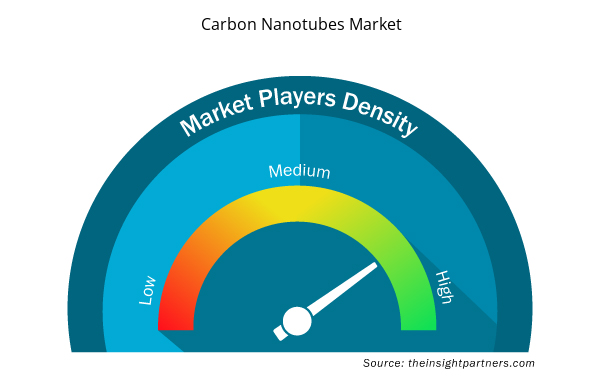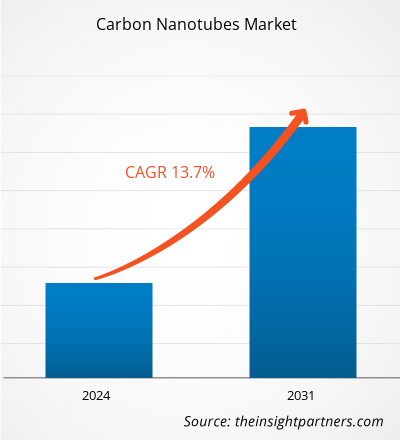The carbon nanotubes market size is projected to reach US$ 18.01 billion by 2031 from US$ 6.45 billion in 2023. The market is expected to register a CAGR of 13.7% during 2023–2031. The incorporation of CNTs in nanocomposite ink for 3D printing can enhance the functionality of advanced printing process and impart electrostatic dissipative properties.
Carbon Nanotubes Market Analysis
The growing demand for lightweight substitutes of metal with superior thermal, electrochemical, and mechanical characteristics has resulted in burgeoning research directed toward finding composites and composite materials. Technological advancements and next-generation microscale applications in the electrical & electronics sector need efficient and high-functionality materials such as CNTs. Further, CNT-based composites technology is widely utilized in aerospace, defense, automotive, and infrastructure industries. National Aeronautics and Space Administration (NASA) funded a five-year Space Technology Research Institute (STRI) called US-COMP, which commenced in 2017, for research and development of CNT-based composites. The research is focused on the innovation of lightweight ultra-high strength material for application in exploration vehicles. Moreover, in 2020, Toray Industries Inc developed a wireless communication process with a printed Radio-Frequency Identifier using semi-conductive CNT-based composites, partially supported by Japan’s Ministry of the Environment. The company’s CNT composite semiconductor offers a mobility of 182 cm2/V-s, compared to low-cost integrated circuits and printed semiconductors, which offer a mobility of 20 cm2/V-s.
Carbon Nanotubes Market Overview
Carbon nanotubes are extremely small cylindrical structures made of carbon atoms. They are known for their unique properties, including high tensile strength, thermal stability, and good electrical conductivity. Single-walled carbon nanotubes and multi-walled carbon nanotubes are two types of carbon nanotubes. Single-walled carbon nanotubes are made of a single layer of carbon atoms rolled into a tube, whereas multi-walled carbon nanotubes consist of several concentric tubes. Carbon nanotubes are used as reinforcement materials in composite materials, sensing materials in sensors, energy storage in batteries, catalysts in chemical reactions, and for biomedical applications. In the medical industry, it is used for drug delivery, biosensors, imaging, and tissue engineering. In the electronics industry, carbon nanotubes are employed as transistors, interconnects, sensors, displays, energy storage, etc.
Customize This Report To Suit Your Requirement
You will get customization on any report - free of charge - including parts of this report, or country-level analysis, Excel Data pack, as well as avail great offers and discounts for start-ups & universities
Carbon Nanotubes Market: Strategic Insights

- Get Top Key Market Trends of this report.This FREE sample will include data analysis, ranging from market trends to estimates and forecasts.
Customize This Report To Suit Your Requirement
You will get customization on any report - free of charge - including parts of this report, or country-level analysis, Excel Data pack, as well as avail great offers and discounts for start-ups & universities
Carbon Nanotubes Market: Strategic Insights

- Get Top Key Market Trends of this report.This FREE sample will include data analysis, ranging from market trends to estimates and forecasts.
Carbon Nanotubes Market Drivers and Opportunities
Increasing Demand for Carbon Nanotubes (CNTs) for Energy Storage Applications
Carbon nanotubes are carbon nanostructures with characteristic electrochemical and mechanical properties such as high strength and rigidity, low density, high heat conductivity, and electrical conductivity. The properties of CNTs are leveraged for the research and development of energy storage systems. Single-walled and multi-walled CNTs are utilized as conductive additives in Li-ion batteries and to develop battery electrodes to enhance battery performance. The rising demand for energy systems, along with its increasing cost, has influenced government organizations and researchers to develop efficient energy systems to fulfill global energy targets.
Adoption of Carbon Nanotubes for Cancer Treatment
The recent advancements in drug delivery and cancer treatment involve the utilization of nanocarriers such as CNTs, solid lipid nanocapsules, magnetic nanoparticles, gold nanoparticles, and liposomes. The electrical, optical, chemical, and mechanical properties of CNTs are employed in drug delivery systems, biomedical imaging, and antimicrobial technology. Therefore, CNT-based anticancer drug delivery technology is gaining popularity, especially due to its selective targeting and controlling of drug delivery. Scientists have developed a novel technology to directly introduce the anticancer drug—doxorubicin—through CNTs from spherical sacs of phospholipid molecules (liposomes) via the cell plasma membrane. A report published by the US Department of Energy in 2022 revealed that CNTs merge liposomes and cancer cells, initiating the merger of liposomal membranes and cancer cells. This fusion process allows the drug to pass freely from the liposome to the cell. This results in the effective delivery of doxorubicin, eliminating up to 90% of disordered cells. Thus, the adoption of CNTs in cancer treatment can create lucrative opportunities for the carbon nanotubes market during the forecast period.
Carbon Nanotubes Market Report Segmentation Analysis
Key segments that contributed to the derivation of the carbon nanotubes market analysis are type and application.
- Based on type, the carbon nanotubes market is divided into multi-walled carbon nanotubes and single-walled carbon nanotubes. The multi-walled carbon nanotubes segment held a larger market share in 2023.
- By application, the market is segmented into electronics and semiconductors, energy storage, structural composites, aerospace and defense, medical, and others. The structural composites segment held the largest share of the market in 2023.
Carbon Nanotubes Market Share Analysis by Geography
The geographic scope of the carbon nanotubes market report is mainly divided into five regions: North America, Asia Pacific, Europe, the Middle East & Africa, and South America/South & Central America.
Asia Pacific dominated the carbon nanotubes market. The Asia Pacific market is segmented into Australia, China, India, Japan, South Korea, and the Rest of Asia Pacific. Asia Pacific has emerged as a major market for carbon nanotubes due to the growing demand for high-performance materials in various industries such as aerospace, automotive, electronics, and energy. The region has become a major hub for carbon nanotubes production, with several leading manufacturers operating in countries such as China, Japan, and South Korea. Moreover, China is one of the largest markets for carbon nanotubes in Asia Pacific, and the country reports significant investments in research and development and increasing adoption of carbon nanotubes in various applications. Several Chinese companies such as Shenzhen Nanotech Port Co. Ltd., Chengdu Organic Chemicals Co. Ltd., and Suzhou NanoGrid Technology Co. Ltd. are involved in the production and commercialization of carbon nanotubes.
Carbon Nanotubes Market Regional Insights
The regional trends and factors influencing the Carbon Nanotubes Market throughout the forecast period have been thoroughly explained by the analysts at Insight Partners. This section also discusses Carbon Nanotubes Market segments and geography across North America, Europe, Asia Pacific, Middle East and Africa, and South and Central America.

- Get the Regional Specific Data for Carbon Nanotubes Market
Carbon Nanotubes Market Report Scope
| Report Attribute | Details |
|---|---|
| Market size in 2023 | US$ 6.45 Billion |
| Market Size by 2031 | US$ 18.01 Billion |
| Global CAGR (2023 - 2031) | 13.7% |
| Historical Data | 2021-2022 |
| Forecast period | 2024-2031 |
| Segments Covered |
By Type
|
| Regions and Countries Covered | North America
|
| Market leaders and key company profiles |
Carbon Nanotubes Market Players Density: Understanding Its Impact on Business Dynamics
The Carbon Nanotubes Market market is growing rapidly, driven by increasing end-user demand due to factors such as evolving consumer preferences, technological advancements, and greater awareness of the product's benefits. As demand rises, businesses are expanding their offerings, innovating to meet consumer needs, and capitalizing on emerging trends, which further fuels market growth.
Market players density refers to the distribution of firms or companies operating within a particular market or industry. It indicates how many competitors (market players) are present in a given market space relative to its size or total market value.
Major Companies operating in the Carbon Nanotubes Market are:
- Nanoshel LLC
- NanoLab Inc
- Kumho Petrochemical Co Ltd
- Klean Industries Inc
- LG Chem Ltd
Disclaimer: The companies listed above are not ranked in any particular order.

- Get the Carbon Nanotubes Market top key players overview
Carbon Nanotubes Market News and Recent Developments
The carbon nanotubes market is evaluated by gathering qualitative and quantitative data post primary and secondary research, which includes important corporate publications, association data, and databases. The following is a list of developments in the market for speech and language disorders:
- In Sep-2020, Arkema partnered with the Korea Association of Carbon-Nano Industry. Partnering with the association will help Arkema to improve its product offerings.
- In August 2020, ChemSpec North America announced a non-exclusive distribution agreement with Belgium-based Nanocyl SA to promote and distribute Nanocyl's various multiwall carbon nanotube ("MWCNT") products in the US and Canada.
- In August 2022, LG Chem announced the expansion of its carbon nanotubes (CNTs) investment with the construction of the world’s largest single-line CNT manufacturing plant.
- In March 2023, Canatu Oy (Vantaa, Finland), a carbon nanomaterial developer, announced an upgrade in its carbon nanotube (CNT) film manufacturing to fulfil the rising demand for ADAS heater products in the automotive industry. Canatu stated that it improved its step-and-repeat (SAR) CNT film production line by adding new reactor capacity and ramping up automation level.
- In April 2020, OCSiAl announced that it can commercialize up to 100 tonnes annually of its TUBALL single-wall carbon nanotubes in Europe due to the company’s upgraded dossier under the EU’s “Registration, Evaluation, Authorization and Restriction of Chemicals” (REACH) legislation, being additionally compliant with the new Annexes on nano forms.
Carbon Nanotubes Market Report Coverage and Deliverables
The “Carbon Nanotubes Market Size and Forecast (2021–2031)” report provides a detailed analysis of the market covering below areas:
- Market size and forecast at global, regional, and country levels for all the key market segments covered under the scope
- Market dynamics such as drivers, restraints, and key opportunities
- Key future trends
- Detailed PEST/Porter’s Five Forces and SWOT analysis
- Global and regional market analysis covering key market trends, major players, regulations, and recent market developments
- Industry landscape and competition analysis covering market concentration, heat map analysis, prominent players, and recent developments
- Detailed company profiles
- Historical Analysis (2 Years), Base Year, Forecast (7 Years) with CAGR
- PEST and SWOT Analysis
- Market Size Value / Volume - Global, Regional, Country
- Industry and Competitive Landscape
- Excel Dataset



Report Coverage
Revenue forecast, Company Analysis, Industry landscape, Growth factors, and Trends

Segment Covered
Type, and Application

Regional Scope
North America, Europe, Asia Pacific, Middle East & Africa, South & Central America

Country Scope
Argentina, Australia, Brazil, Canada, China, France, Germany, India, Italy, Japan, Mexico, Russia, Saudi Arabia, South Africa, South Korea, United Arab Emirates, United Kingdom, United States

 Get Free Sample For
Get Free Sample For